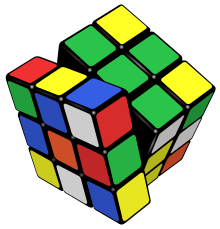Algebra
Main article: Algebra

The quadratic formula, which concisely expresses the solutions of all quadratic equations
The Rubik's Cube group is a concrete application of group theory
Algebra is the art of manipulating equations and formulas. Diophantus (3rd century) and al-Khwarizmi (9th century) were the two main precursors of algebra. Diophantus solved some equations involving unknown natural numbers by deducing new relations until he obtained the solution. Al-Khwarizmi introduced systematic methods for transforming equations, such as moving a term from one side of an equation into the other side. The term algebra is derived from the Arabic word al-jabr meaning 'the reunion of broken parts' that he used for naming one of these methods in the title of his main treatise.
Algebra became an area in its own right only with François Viète (1540–1603), who introduced the use of variables for representing unknown or unspecified numbers. Variables allow mathematicians to describe the operations that have to be done on the numbers represented using mathematical formulas.
Until the 19th century, algebra consisted mainly of the study of linear equations (presently linear algebra), and polynomial equations in a single unknown, which were called algebraic equations (a term still in use, although it may be ambiguous). During the 19th century, mathematicians began to use variables to represent things other than numbers (such as matrices, modular integers, and geometric transformations), on which generalizations of arithmetic operations are often valid. The concept of algebraic structure addresses this, consisting of a set whose elements are unspecified, of operations acting on the elements of the set, and rules that these operations must follow. The scope of algebra thus grew to include the study of algebraic structures. This object of algebra was called modern algebra or abstract algebra, as established by the influence and works of Emmy Noether. (The latter term appears mainly in an educational context, in opposition to elementary algebra, which is concerned with the older way of manipulating formulas.)
Some types of algebraic structures have useful and often fundamental properties, in many areas of mathematics. Their study became autonomous parts of algebra, and include:
- group theory;
- field theory;
- vector spaces, whose study is essentially the same as linear algebra;
- ring theory;
- commutative algebra, which is the study of commutative rings, includes the study of polynomials, and is a foundational part of algebraic geometry;
- homological algebra;
- Lie algebra and Lie group theory;
- Boolean algebra, which is widely used for the study of the logical structure of computers.
The study of types of algebraic structures as mathematical objects is the purpose of universal algebra and category theory. The latter applies to every mathematical structure (not only algebraic ones). At its origin, it was introduced, together with homological algebra for allowing the algebraic study of non-algebraic objects such as topological spaces; this particular area of application is called algebraic topology.






